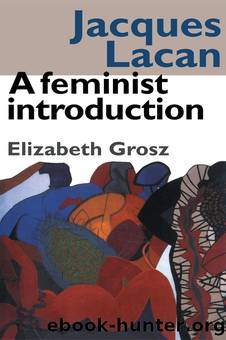Jacques Lacan by Unknown

Author:Unknown
Language: eng
Format: epub
ISBN: 978-1-134-98108-3
Publisher: Taylor & Francis (CAM)
Figure 8
There are several overlapping associations or repeated elements in Freud’s recollections: ‘Königstein’, ‘Gartner’, ‘hobbies’, ‘artichokes’, and ‘monograph’, each representing a nodal point necessary for unravelling the dream’s latent structure. Condensed into these nodal points are the meanings and intensities – the signifying traces – of the unconscious impulses. These nodal points are points of overdetermination, multiple meaning, and ambiguity in the dream. They indicate that there are a number of paths leading from the manifest dream to the unconscious signifiers:
The first investigation leads us to conclude that the elements ‘botanical’ and ‘monograph’ found their way into the content of the dream-thoughts, because, that is to say, they constituted ‘nodal points’ upon which a great number of the dream-thoughts converged and because they had several meanings in connection with the interpretation of the dream. The explanation of this fundamental fact can also be put another way: to have been represented in the dream-thoughts many times over. (ibid.: 283)
The dream has no meaning apart from this wide network of associations which provide its (linguistic) context. in itself, it remains strictly unintelligible. Only when positioned within a verbal structure, i.e., in the first case, by the dream report; and in the second, through the chains of association – can it be deciphered. We can make connections between the dream’s largely visual imagery and its underlying linguistic structure only through the dream’s verbalization.
While these associations are prolific and revealing, they do not provide anything resembling meaning in its ordinary or literary sense. The associative chains are webs of signifiers in non-sensical, a-grammatical, and a-syntactical arrangements. As Freud suggests, they exist side by side, each unaffected by the others. We must extrapolate from these key unassimilated signifiers to the unconscious wish. The wish-like form is generated by the libidinal, striving, yearning nature of these unconscious elements. They are wishes in so far as they strive for consciousness. These wishes are ultimately supported by fantasies, narratives constructed by the unconscious through its access to perceptual images in memory systems.
In the dream of the ‘Botanical Monograph’, Freud only presents us with the preconscious wish, as he does in virtually all the examples in The Inrerpretation. They are only partially analysed. He stops short of the unconscious in his explanations: ‘I can assure my readers that the ultimate meaning of the dream, which I have nor disclosed, is intimately related to the subject of a childhood scene’ (ibid.: 191, emphasis added). Freud’s wish to write a fertile text, which began with a metaphoric equivalence between the desire for the mother and desire for books, dates from the erotic scene in which he and his sister voluptuously tear up the coloured book leaf by leaf. This infantile scene provides connections with the repressed, oedipal wish for the mother, and prefigures his father’s gift of the bible to his young son. This scene also mediates the two scenes comprising the day’s residues, providing an intermediary link between the unconscious and the preconscious. The unconscious, oedipal wish is disguised by a preconscious ambition wish.
Download
This site does not store any files on its server. We only index and link to content provided by other sites. Please contact the content providers to delete copyright contents if any and email us, we'll remove relevant links or contents immediately.
Call Me by Your Name by André Aciman(18980)
Ready Player One by Cline Ernest(12859)
How to Be a Bawse: A Guide to Conquering Life by Lilly Singh(6699)
Wiseguy by Nicholas Pileggi(4598)
The Kite Runner by Khaled Hosseini(4464)
On Writing A Memoir of the Craft by Stephen King(4220)
The Crown by Robert Lacey(4112)
Audition by Ryu Murakami(4103)
Call me by your name by Andre Aciman(4075)
Harry Potter and the Cursed Child: The Journey by Harry Potter Theatrical Productions(3980)
Gerald's Game by Stephen King(3925)
The Perils of Being Moderately Famous by Soha Ali Khan(3789)
Dialogue by Robert McKee(3589)
Dynamic Alignment Through Imagery by Eric Franklin(3494)
Apollo 8 by Jeffrey Kluger(3204)
How to be Champion: My Autobiography by Sarah Millican(3192)
Seriously... I'm Kidding by Ellen DeGeneres(3105)
Darker by E L James(3092)
History of Dance, 2E by Gayle Kassing(3001)
